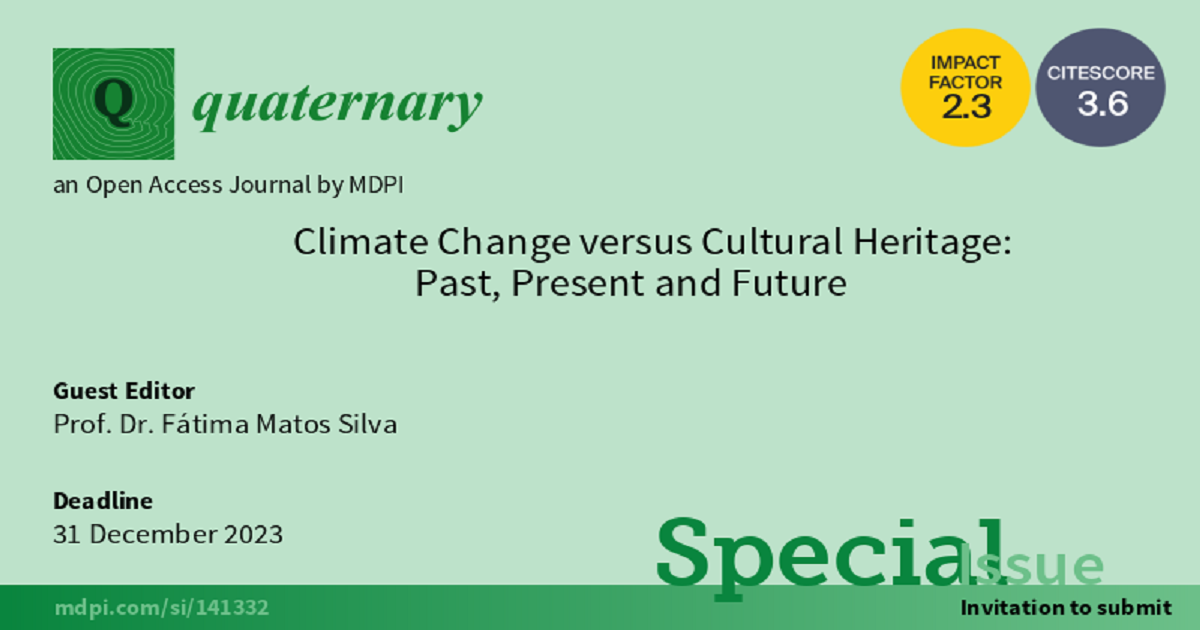- 2.1Impact Factor
- 4.1CiteScore
- 39 daysTime to First Decision
Climate Change versus Cultural Heritage: Past, Present and Future
Special Issue Information
Dear Colleagues,
Cultural heritage is one of the pillars of society and forms the identity of peoples. Since prehistoric times, humankind has created and built objects and structures with a diverse range of organic and inorganic supports. Over time, these have transformed into objects of cultural heritage, telling the stories of a (more or less) distant past and preserving the memory and culture of the peoples that preceded us.
In recent decades, cultural heritage sites have hosted thousands of visitors, boosting the social and economic sustainability of nearby populations. However, the degradation of cultural heritage sites has increased to an unprecedented scale due to climate change.
The climate crisis directly and indirectly threatens all kinds of cultural heritage, whether it is a World Heritage Site, a small chapel in rural areas, cave paintings and rock engravings, an Iron Age hillfort, or a medieval castle. Extreme weather events—including abundant rainfall, floods, rising sea levels, prolonged heat waves, drought, strong winds, fires, and erosion—which will become increasingly frequent, have immediate consequences, and naturally speed up the rate of natural degradation processes. These processes, anthropic, chemical, physical, or biological in origin, cause the degradation of materials, leading to a greater need for conservation and restoration of cultural heritage, including outdoors sites and objects of cultural significance stored in museums, libraries, and archives.
Despite rising concerns regarding cultural heritage degradation, little is known about the impacts of the climate crisis on cultural heritage and how this potentiates the usual factors of deterioration. The scientific literature in this area and studies focused on preventive solutions remain scarce. As such, with this Special Issue, we intend to address some of these gaps, encouraging researchers from different backgrounds to explore, via a multidisciplinary, interdisciplinary and transversal approach, climate change’s impact on cultural heritage.
The topics of interest for this issue include, but are not limited to, the following:
- current and emerging climate change impacts and threats to cultural heritage
- cultural heritage adaptation and mitigation practices to curb effects of climate change
- cultural heritage monitorization to reduce climate-change-related impacts
- cultural heritage damage mechanisms
- cultural heritage and factors of deterioration over time
- challenges and actions for preservation and conservation
- preventive conservation of cultural heritage
- methods and technics of study and monitorization
- coastal erosion and sea level rise as threats to cultural heritage
- floods and landslides and their impact on cultural heritage
- windstorm and heavy rainfall as threats to cultural heritage
- heat waves and fires as threats to cultural heritage
Prof. Dr. Fátima Matos Silva
Guest Editor
Manuscript Submission Information
Manuscripts should be submitted online at www.mdpi.com by registering and logging in to this website. Once you are registered, click here to go to the submission form. Manuscripts can be submitted until the deadline. All submissions that pass pre-check are peer-reviewed. Accepted papers will be published continuously in the journal (as soon as accepted) and will be listed together on the special issue website. Research articles, review articles as well as short communications are invited. For planned papers, a title and short abstract (about 250 words) can be sent to the Editorial Office for assessment.
Submitted manuscripts should not have been published previously, nor be under consideration for publication elsewhere (except conference proceedings papers). All manuscripts are thoroughly refereed through a single-blind peer-review process. A guide for authors and other relevant information for submission of manuscripts is available on the Instructions for Authors page. Quaternary is an international peer-reviewed open access quarterly journal published by MDPI.
Please visit the Instructions for Authors page before submitting a manuscript. The Article Processing Charge (APC) for publication in this open access journal is 1600 CHF (Swiss Francs). Submitted papers should be well formatted and use good English. Authors may use MDPI's English editing service prior to publication or during author revisions.

Benefits of Publishing in a Special Issue
- Ease of navigation: Grouping papers by topic helps scholars navigate broad scope journals more efficiently.
- Greater discoverability: Special Issues support the reach and impact of scientific research. Articles in Special Issues are more discoverable and cited more frequently.
- Expansion of research network: Special Issues facilitate connections among authors, fostering scientific collaborations.
- External promotion: Articles in Special Issues are often promoted through the journal's social media, increasing their visibility.
- e-Book format: Special Issues with more than 10 articles can be published as dedicated e-books, ensuring wide and rapid dissemination.

